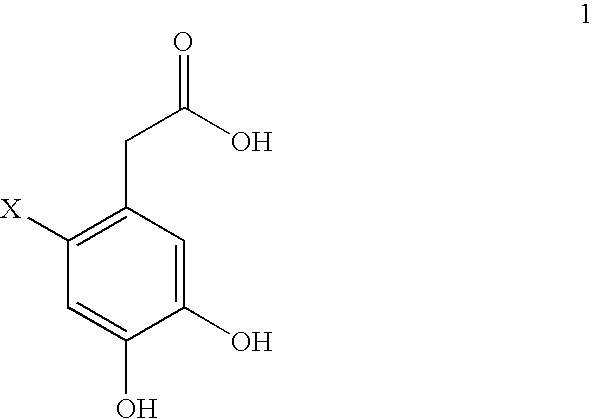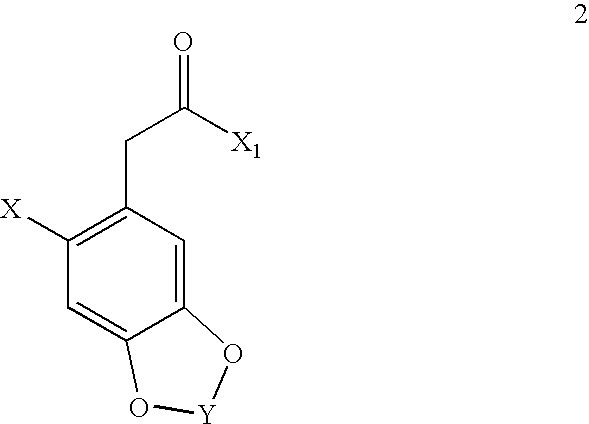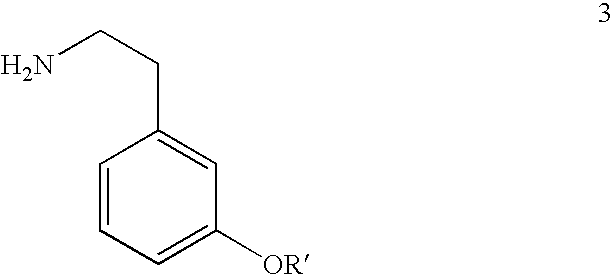Opiate Intermediates and Methods of Synthesis
a technology of intermediates and opiate, applied in the field of opiate intermediates and methods of synthesis, can solve the problems of low overall yield, no suitable for scale-up to a standard manufacturing process, and only providing racemic materials
- Summary
- Abstract
- Description
- Claims
- Application Information
AI Technical Summary
Benefits of technology
Problems solved by technology
Method used
Image
Examples
example 1
Chlorination of Formula 14
[0089] Formula 14 (238.0 g, 1.21 mol) when added to THF / c-HCl (1250 mL / 125 mL) formed a yellow solution. The solution was cooled down to −10° C. in a dry-ice / i-PrOH bath. N-chlorosuccimide (NCS) (170.0 g, 1.05 eq) was added in five portions over a 2 h period. Water (1200 mL) was then added. Solvent (˜1500 mL) was distilled off until distillate vapor temperature reached 100° C. The mixture with stirring was allowed to cool down overnight to give crystals. It was filtered. The filtrate (1250 mL) was obtained and HPLC analysis indicated that it contained 5 grams of product. The solid washed with water (200 mL, 150 mL×2) and dried in flowing air for 4 hours to give 326.8 g of wet solid of pure product by HPLC analysis.
example 2
Preparation of Formula 15
[0090] The crude product of Example 1 was suspended in 48% HBr and heated to 90° C. for form a brown solution. It was stirred at 90° C. for 6 h, heated at 100° C. for 3 h and then cooled to room temperature. The suspension was left stirring over the weekend. The mixture was filtered and the recovered solid washed with water (600 mL). The solid was dried in flowing air for 4 h to give 256 g of solid. It was dissolved in refluxing ethyl acetate (1000 mL). 100 grams of activated carbon was added. The mixture was refluxed for another 10 minutes and filtered hot. The filter washed with hot ethyl acetate (250 mL×2). The combined organic solutions were taken to dryness under vacuum, and the product (156.05 g) was recovered as off white solid.
example 3
Preparation of Formula 15
[0091] To a solution of the dried product of Example 1 (55.0 g, 0.238 mol) in CH2Cl2 (500 mL) at 10° C., BBr3 (50 mL, 2.2 eq) was added. The mixture was stirred for 30 minutes after the addition was completed and then poured into water (1000 mL), it was heated to reflux for 1 hour. Dichloromethane was removed by distillation until the distillate vapor temperature reached 100° C. The remaining solution was allowed to cool down and then extracted with ethyl acetate (300 mL, 150 mL×2). The combined organic layers were washed with water (300 mL×2) and taked to dryness under vacuum to give 41.5 g of product as solid.
PUM
| Property | Measurement | Unit |
|---|---|---|
| temperature | aaaaa | aaaaa |
| temperature | aaaaa | aaaaa |
| temperature | aaaaa | aaaaa |
Abstract
Description
Claims
Application Information
 Login to View More
Login to View More - R&D
- Intellectual Property
- Life Sciences
- Materials
- Tech Scout
- Unparalleled Data Quality
- Higher Quality Content
- 60% Fewer Hallucinations
Browse by: Latest US Patents, China's latest patents, Technical Efficacy Thesaurus, Application Domain, Technology Topic, Popular Technical Reports.
© 2025 PatSnap. All rights reserved.Legal|Privacy policy|Modern Slavery Act Transparency Statement|Sitemap|About US| Contact US: help@patsnap.com



